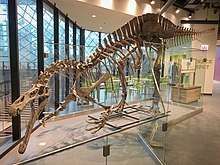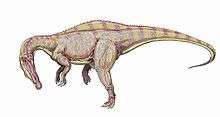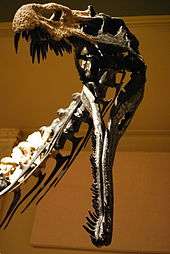Suchomimus
| Suchomimus | |
|---|---|
 | |
| Mounted skeleton, Chicago Children's Museum. | |
| Scientific classification | |
| Kingdom: | Animalia |
| Phylum: | Chordata |
| Clade: | Dinosauria |
| Order: | Saurischia |
| Suborder: | Theropoda |
| Family: | †Spinosauridae |
| Genus: | †Suchomimus Sereno et al., 1998 |
| Species: | †S. tenerensis |
| Binomial name | |
| Suchomimus tenerensis Sereno et al., 1998 | |
| Synonyms | |
| |
Suchomimus (meaning "crocodile mimic") is a genus of large theropod dinosaur with a crocodile-like skull that lived between 125–112 million years ago,[1] during the Aptian to early Albian stage of the Cretaceous period in Niger, Africa. It belongs in the Spinosauridae family and the only species named in the genus is Suchomimus tenerensis. Like other spinosaurids, it likely had a diet of mostly fish.[2]
Description

The length of the type specimen of Suchomimus, a subadult, was initially estimated at 10.3–11 m (34–36 ft). Its weight was estimated at between 2.7 and 5.2 tonnes (2.7 and 5.1 long tons; 3.0 and 5.7 short tons).[3][4][1] In 2010, Gregory S. Paul gave lower estimations of 9.5 metres and 2.5 tonnes.[5]
The describers established some unique derived traits (autapomorphies) of Suchomimus. The praemaxilla has an upward branch excluding the maxilla from the bony nostril. The neural spines on the rear dorsal, sacral and front tail vertebrae are expanded in side view. The upper corners of the humerus are robust. The humerus has a boss above the condyle that contacts its hook-shaped radius.[6] The neck is relatively short but well-muscled as shown by strong epipophyses. There are about sixteen back vertebrae. Suchomimus had unusually extended neural spines, blade-shaped upward extensions on the vertebrae, which are elongated at the rear back. Those of the five sacral vertebrae are the longest. The elongation of these structures continue until the middle tail. The spines may have held up some kind of low crest or sail of skin that was highest over its hips, lower and extending further to the back than that of Spinosaurus.[6]

The furcula is V-shaped and indicates a high and narrow trunk.[7] The humerus is very strongly built, only equalled in size among theropoda by that of Megalosaurus and Torvosaurus. Accordingly, the ulna of the lower arm is well-developed with an enormous olecranon, upper process, that is set-off from the shaft, an exceptional trait shared with Baryonyx. The heavy arm musculature powered sizable hand claws, that of the thumb being the largest with a length of 19 cm.[6]
In the pelvis, the ilium is high. The pubic bone has a front surface that is wider than the side surface. The thighbone is straight and robust, 1075 millimetres long in the holotype. Its lesser trochanter is markedly plate-like.[6]
Skull

Unlike most giant theropods, Suchomimus had a very long, low snout and narrow jaws, formed by a forward expansion of the premaxilla and the anterior ramus of the maxilla. The jaws have about 122 conical teeth, pointed but not very sharp and curving slightly backward, with fine serrations. The tip of the snout was enlarged sideways and carried a "rosette" of longer teeth, seven per side in the skull and about the same number in the corresponding part of the lower jaw. Further back, there are at least twenty-two teeth per upper jaw side in the maxilla, while the entire lower jaw side carries thirty-two teeth in the dentary bone. The upper jaw shows a prominent kink just behind the rosette, protruding to below; this convexly curved part of the maxilla has the longest teeth of the entire skull. The skull is reminiscent of that of crocodilians that eat mainly fish. The internal bone shelves of the maxillae meet each other over a long distance, forming a closed front palate rigidifying the snout. The nostrils are long, narrow and horizontally positioned; the same is true of the larger antorbital fenestra. The rear of the skull is poorly known but for a short quadrate, separated from the quadratojugal by a large foramen quadraticum, shows it must have been low. The lower jaws are very elongated and narrow, forming a rigid structure as their dentaries touch each other at the midline, reinforcing the mandible against torsional forces.[6]
Discovery and naming
In 1997, palaeontologist Paul Sereno and his team at Gadoufaoua discovered fossils that represented about two-thirds of the skeletal elements of a large carnivorous theropod in Niger. The first find, a giant thumb claw, was made on 4 December 1997 by David Varricchio. On 11 November 1998, Paul Sereno, Allison Beck, Didier Dutheil, Boubacar Gado, Hans Larsson, Gabrielle Lyon, Jonathan Marcot, Oliver Walter Mischa Rauhut, Rudyard Sadleir, Christian Sidor, David Varricchio, Gregory Wilson and Jeffrey Wilson named and described the type species Suchomimus tenerensis. The generic name Suchomimus ("crocodile mimic") is derived from the Greek σοῦχος, souchos, the Greek name for the Egyptian crocodile god Sobek, and μῖμος, mimos, "mimic", after the shape of the animal's head. The specific name tenerensis is after the Ténéré Desert where the animal was found.[6]

The holotype, MNN GDF500, was found in the Tegama Beds of the Elrhaz Formation dating from the Aptian. It consists of a partial skeleton lacking the skull. It contains three neck ribs, parts of fourteen back vertebrae, ten dorsal ribs, belly ribs, pieces of three sacral vertebrae, parts of twelve tail vertebrae, chevron bones, a shoulder blade, a coracoid, a forelimb, a pelvis side, and parts of a hindlimb. The vertebral column was largely articulated, the remainder consisted of disarticulated bones. Parts of the skeleton had been exposed on the desert surface and had suffered erosion damage. Additionally, several specimens have been assigned as paratypes: MNHN GDF 501, a snout; MNHN GDF 502, a quadrate; MNHN GDF 503, a dentary; MNHN GDF 504, a dentary; MNHN GDF 505, a dentary; MNHN GDF 506: an axis; MNHN GDF 507, a rear neck vertebra; MNHN GDF 508, a rear back vertebra; MNHN GDF 510, a tail vertebra; and MNHN GDF 511, another tail vertebra. The fossils are part of the collection of the Musée National du Niger.[6] The initial description of Suchomimus was preliminary. In 2007, the furcula, found during a subsequent expedition in 2000, was described in detail.[7]
Classification

Suchomimus was placed in the Spinosauridae, a group of large predators with jaws adapted for hunting fish and with flatter skulls when compared to other similarly-sized theropods, like the Tyrannosauridae. Their teeth were adapted for grasping rather than slicing and the roof of the mouth was more solid, allowing the spinosaurids to resist twisting forces exerted by prey. The rest of the body was not particularly adapted to the water.[8]
Within the Spinosauridae, Suchomimus was a member of the Baryonychinae. Apart from its possibly higher back crest, Suchomimus was very similar to the spinosaurid Baryonyx from the Barremian of England which also had strong forelimbs and a huge sickle-curved claw on its "thumb". And, as with Suchomimus, the claw of Baryonyx had been the first fossil part to be found in the field. The holotype of Suchomimus was considerably larger than that of Baryonyx, but the ages of the two individuals are not known. In 2002, several researchers concluded that Suchomimus was identical to Cristatusaurus lapparenti found in the same formation of Niger and, despite Cristatusaurus having been named somewhat earlier than Suchomimus, proposed them to represent a second species of Baryonyx called Baryonyx tenerensis.[9]

Sereno et al. (1998) analyzed the distribution of forty-five traits to produce a cladogram that showed Suchomimus and Baryonyx to be distinct but closely related.
The following Phylogenetic tree shows a 2009 analysis of the Megalosauroidea.[10]
| Megalosauroidea |
| ||||||||||||||||||||||||
Palaeoecology

The Elrhaz Formation, part of the Tegama Group, consists mainly of fluvial sandstones with low relief, much of which is obscured by sand dunes.[11][12] The sediments are coarse- to medium-grained, with almost no fine-grained horizons.[13] Suchomimus lived in what is now Niger, during the late Aptian to early Albian stages of the Early Cretaceous, 112 million years ago.[14][15] The sediment layers of the formation have been interpreted as an inland habitat of extensive freshwater floodplains and fast-moving rivers, with a tropical climate that likely experienced seasonal dry periods.[14]
This environment was home to a variety of fauna including dinosaurs, pterosaurs, chelonians, fish, hybodont sharks, and freshwater bivalves.[15][12] Suchomimus coexisted with other theropods like the abelisaurid Kryptops, the carcharodontosaurid Eocarcharia, and an unknown noasaurid. Herbivorous dinosaurs of the region included iguanodontians like Ouranosaurus, Elrhazosaurus, Lurdusaurus, and two sauropods: Nigersaurus, and an unnamed titanosaur. Crocodylomorphs were abundant; represented by the giant pholidosaur species Sarcosuchus imperator, as well as small notosuchians like Anatosuchus minor, Araripesuchus wegeneri, and Stolokrosuchus lapparenti.[12] The local flora probably consisted mainly of ferns, horsetails, and angiosperms, based on the dietary adaptations of the large diplodocoids that lived there.[14]
References
- 1 2 Holtz, Thomas R. Jr. (2012) Dinosaurs: The Most Complete, Up-to-Date Encyclopedia for Dinosaur Lovers of All Ages, Winter 2011 Appendix.
- ↑ Rayfield, Emily J. 2011. “Structural Performance of Tetanuran Theropod Skulls, with Emphasis on the Megalosauridae, Spinosauridae and Carcharodontosauridae.” Special Papers in Palaeontology 86 (November). https://www.researchgate.net/publication/250916680_Structural_performance_of_tetanuran_theropod_skulls_with_emphasis_on_the_Megalosauridae_Spinosauridae_and_Carcharodontosauridae.
- ↑ Therrien, François; Henderson, Donald M. (2007). "My theropod is bigger than yours … or not: estimating body size from skull length in theropods". Journal of Vertebrate Paleontology. 27 (1): 108–115. doi:10.1671/0272-4634(2007)27[108:MTIBTY]2.0.CO;2. Retrieved 2013-03-19.
- ↑ Nicolás E. Campione, David C. Evans, Caleb M. Brown, Matthew T. Carrano (2014). Body mass estimation in non-avian bipeds using a theoretical conversion to quadruped stylopodial proportions. Methods in Ecology and Evolution. doi:10.1111/2041-210X.12226
- ↑ Paul, G.S., 2010, The Princeton Field Guide to Dinosaurs, Princeton University Press p. 87
- 1 2 3 4 5 6 7 Sereno, P.C.; Beck, A.L.; Dutheil, D.B.; Gado, B.; Larsson, H.C.E.; Lyon, G.H.; Marcot, J.D.; Rauhut, O.W.M.; Sadleir, R.W.; Sidor, C.A.; Varricchio, D.D.; Wilson, G.P; Wilson, J.A. (1998). "A long-snouted predatory dinosaur from Africa and the evolution of spinosaurids". Science. 282 (5392): 1298–1302. Bibcode:1998Sci...282.1298S. doi:10.1126/science.282.5392.1298. PMID 9812890. Retrieved 2013-03-19.
- 1 2 Lipkin, Christine; Paul; Sereno, Callistus; Horner, Jack (2007). "The furcula in Suchomimus tenerensis and Tyrannosaurus rex (Dinosauria: Theropoda: Tetanurae)". Journal of Paleontology. 81 (6): 1523–1527. doi:10.1666/06-024.1.
- ↑ Holtz, T.R., Jr (1998). "Spinosaurs as crocodile mimics". Science. 282 (5392): 1276–1277. doi:10.1126/science.282.5392.1276. Retrieved 2013-03-19.
- ↑ Sues, H.-D.; Frey, E.; Martill, M.; Scott, D.M. (2002). "Irritator challengeri, a spinosaurid (Dinosauria: Theropoda) from the Lower Cretaceous of Brazil". Journal of Vertebrate Paleontology. 22 (3): 535–547. doi:10.1671/0272-4634(2002)022[0535:icasdt]2.0.co;2.
- ↑ Benson, R. B. J.; Carrano, M. T.; Brusatte, S. L. (2009). "A new clade of archaic large-bodied predatory dinosaurs (Theropoda: Allosauroidea) that survived to the latest Mesozoic". Naturwissenschaften. 97 (1): 71–78. Bibcode:2010NW.....97...71B. doi:10.1007/s00114-009-0614-x. PMID 19826771.
- ↑ Sereno, P. C.; Beck, A. L.; Dutheil, D. B.; Larsson, H. C.; Lyon, G. H.; Moussa, B.; Sadleir, R. W.; Sidor, C. A.; Varricchio, D. J.; Wilson, G. P.; Wilson, J. A. (1999). "Cretaceous sauropods from the Sahara and the uneven rate of skeletal evolution among dinosaurs". Science. 286 (5443): 1342–1347. doi:10.1126/science.286.5443.1342. PMID 10558986.
- 1 2 3 Sereno, P. C.; Brusatte, S. L. (2008). "Basal abelisaurid and carcharodontosaurid theropods from the Lower Cretaceous Elrhaz Formation of Niger". Acta Palaeontologica Polonica. 53 (1): 15–46. doi:10.4202/app.2008.0102.
- ↑ Sereno, P. C.; Wilson, J. A.; Witmer, L. M.; Whitlock, J. A.; Maga, A.; Ide, O.; Rowe, T. A. (2007). "Structural extremes in a Cretaceous dinosaur". PLoS ONE. 2 (11): e1230. Bibcode:2007PLoSO...2.1230S. doi:10.1371/journal.pone.0001230. PMC 2077925. PMID 18030355.

- 1 2 3 Sereno, P. C.; Wilson, J. A.; Witmer, L. M.; Whitlock, J. A.; Maga, A.; Ide, O.; Rowe, T. A. (2007). "Structural extremes in a Cretaceous dinosaur". PLoS ONE. 2 (11): e1230. Bibcode:2007PLoSO...2.1230S. doi:10.1371/journal.pone.0001230. PMC 2077925. PMID 18030355.
.

- 1 2 Sereno, Paul C.; Larson, Hans C. E.; Sidor, Christian A.; Gado, Boubé (2001). "The Giant Crocodyliform Sarcosuchus from the Cretaceous of Africa". Science. 294 (5546): 1516–1519. Bibcode:2001Sci...294.1516S. doi:10.1126/science.1066521. PMID 11679634.
External links
| Wikispecies has information related to Suchomimus |
| Wikimedia Commons has media related to Suchomimus. |
- Paul Sereno - Project Exploration Suchomimus Fact Sheet, at Project Exploration.
- Photos of Suchomimus Skeleton in Niger, at Project Exploration.
- Video of mounted Suchomimus skeleton in Chicago at the Field Museum

.jpg)
.png)